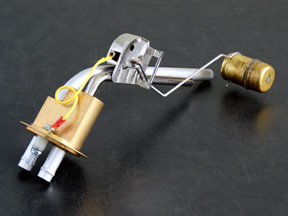
Volume 3, Issue 2
September 2009
Unsubscribe
The smaller the micron rating of a filter, the smaller the particle it will catch. However, for a given size filter, the smaller the micron rating, the more restrictive the filter. All things equal, the filter before the pump should be freer flowing than the filter after the pump. This is because the fuel before the pump is under a vacuum and is more likely to vaporize or cause pump cavitation.
One way to make a filter flow more is to make it larger so it has an element with more surface area. The other way to make a filter flow more is to use an element with a larger micron rating. So, if you use two filters with the same micron rating, the one before the pump needs to be bigger. The alternative is to use two filters of the same size but with the filter before the pump having a larger micron rating.
Fortunately, the filter before the pump generally doesn't need to filter as finely as the filter after the pump because the pump is not as sensitive to contaminants as the carb or injectors. A 90 to 200 micron filter will filter well enough for mechanical pumps and rotary vane style electric pumps. Gerotor style pumps have tighter internal clearances and thus require a prefilter of about 30 to 50 microns. The filter after the pump needs to filter out smaller particles than the prefilter. A 30 to 50 micron will work for a carb and 5 to 10 microns will work for FI.
To summarize, the prefilter needs to flow more than the post-filter. To accomplish this, the prefilter needs to either be much larger than the post filter, or have a larger micron rating, or both.
— Robb

RobbMc 1/2" Sending Units
Drop-in replacement for factory 5/16" or 3/8" sending units. Budget alternative to a fuel cell or weld-on sump. Recommended for cars with engines over 450 hp. Recommended for all cars with an electric fuel pump and return/bypass style regulator
Applications
1964-67 GM A-Body
1968-72 GM A-Body
1967-69 GM F-Body
1970-73 GM F-Body
1974-81 GM F-Body
1968-72 GM X-Body
1973-79 GM X-Body
New Ford Sending Units
In Stock Now!
1964-68 Ford Mustang
1969 Ford Mustang
1970 Ford Mustang
Features
Sending Unit Options:
–8AN Male Fittings
Added to the ends of the feed and return tubes.
Reducer, 1/2" to 1/4" hose
Required when using a mechanical pump with 1/4" vapor return line.
RobbMc 1/2" Sending Units are now available. Order by phone or online through our secure Paypal shopping cart.
RobbMc Performance Products
775.885.7411
Drop-in replacement for factory 5/16" or 3/8" sending units. Budget alternative to a fuel cell or weld-on sump. Recommended for cars with engines over 450 hp. Recommended for all cars with an electric fuel pump and return/bypass style regulator
Applications
1964-67 GM A-Body
1968-72 GM A-Body
1967-69 GM F-Body
1970-73 GM F-Body
1974-81 GM F-Body
1968-72 GM X-Body
1973-79 GM X-Body
New Ford Sending Units
In Stock Now!
1964-68 Ford Mustang
1969 Ford Mustang
1970 Ford Mustang
Features
- 1/2" pickup and feed tubes reduce flow restriction to suction side of fuel pump
- 1/2" return tube allows use of a return/bypass regulator without modifying the fuel tank or switching to a fuel cell
- Return tube can be capped off if no return line is used
- Use with a reducer to connect 1/4" vapor return line from a mechanical pump
- Billet aluminum base and aluminum tubes are anodized for use with gasoline or alcohol
- Stainless fuel level sending unit works with OEM fuel level gauges
- Eliminates restrictive, difficult to service intank "sock" filter. Use with RobbMc inline prefilter
- MADE IN THE USA
Sending Unit Options:
–8AN Male Fittings
Added to the ends of the feed and return tubes.
Reducer, 1/2" to 1/4" hose
Required when using a mechanical pump with 1/4" vapor return line.
RobbMc 1/2" Sending Units are now available. Order by phone or online through our secure Paypal shopping cart.
RobbMc Performance Products
775.885.7411
To unsubscribe from the free RobbMc Performance Newsletter, click the "Unsubscribe" link at the top of this newsletter. Or send an email to news@robbmcperformance.com and place the word "Remove" in the subject line of the email.